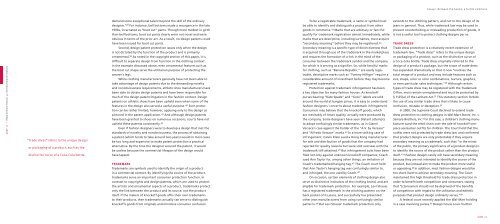Testimony of David Wolfe, Creative Director The ... - Public Knowledge
Testimony of David Wolfe, Creative Director The ... - Public Knowledge
Testimony of David Wolfe, Creative Director The ... - Public Knowledge
You also want an ePaper? Increase the reach of your titles
YUMPU automatically turns print PDFs into web optimized ePapers that Google loves.
E s s a y s : B e t w e e n t h e S e a m s , a F e r t i l e C o m m o n s<br />
demand some exceptional talent beyond the skill <strong>of</strong> the ordinary<br />
designer.” 38 For instance, bell bottoms made a resurgence in the late<br />
1990s, incarnated as “boot cut” pants. Though more modest in girth<br />
than bell bottoms, boot cut pants clearly were not novel and were<br />
obvious in terms <strong>of</strong> the prior art. As a result, no design patents could<br />
have been issued for boot cut pants.<br />
Second, design patent protection issues only when the design<br />
is not dictated by the function <strong>of</strong> the product and is primarily<br />
ornamental. 39 As noted in the copyright section <strong>of</strong> this paper, it is<br />
difficult to separate design from function in the clothing context.<br />
In the example discussed above, even ornamental features such as<br />
the boot cut shape serve the utilitarian purpose <strong>of</strong> protecting the<br />
wearer’s legs.<br />
While clothing manufacturers generally have not been able to<br />
take advantage <strong>of</strong> design patents due to the demanding novelty<br />
and nonobviousness requirements, athletic shoe manufacturers have<br />
been able to obtain design patents and have been responsible for<br />
much <strong>of</strong> the design patent litigation in the fashion context. Design<br />
patents on athletic shoes have been upheld even when some <strong>of</strong> the<br />
features in the design also served a useful purpose. 40 Such protection<br />
can be rather limited, however, applying only to the design as<br />
pictured in the patent application. 41 And although design patents<br />
have been granted to shoes on numerous occasions, courts have not<br />
upheld these patents consistently. 42<br />
Even if fashion designers were to develop a design that met the<br />
standards <strong>of</strong> novelty and nonobviousness, the process <strong>of</strong> obtaining<br />
a patent (which tends to take around two years) would in most cases<br />
be too long and expensive to make patent protection a practical<br />
alternative. By the time the designer secured the patent, it would<br />
be useless because the commercial lifespan <strong>of</strong> the design would<br />
have lapsed.<br />
To be a registrable trademark, a name or symbol must<br />
extends to the stitching pattern, and not to the design <strong>of</strong> its<br />
jeans in general. Thus, while trademark law may be used to<br />
prevent counterfeiting or misleading production <strong>of</strong> goods, it<br />
is not a useful tool to protect clothing designs per se.<br />
be able to identify and distinguish a product from other<br />
goods in commerce. 43 Marks that are arbitrary or fanciful<br />
qualify for trademark registration almost immediately, while<br />
marks that are descriptive, including surnames, must acquire<br />
“secondary meaning” before they may be registered. 44<br />
Secondary meaning is a specific type <strong>of</strong> distinctiveness that<br />
is acquired through use <strong>of</strong> the trademark in the marketplace<br />
and requires the formation <strong>of</strong> a link in the mind <strong>of</strong> the<br />
consumer between the trademark symbol and the company<br />
for which it is serving as a signifier. So, while fanciful marks<br />
for clothing, such as “Banana Republic,” are easily registrable,<br />
descriptive marks such as “Tommy Hilfiger” require a<br />
considerable amount <strong>of</strong> investment before they may become<br />
registered trademarks.<br />
Protection against trademark infringement has been<br />
a key objective for many fashion houses. As knock<strong>of</strong>f<br />
purses bearing “Kate Spade” and “Gucci” labels are sold<br />
around the world at bargain prices, it is easy to understand<br />
fashion designers’ concerns about trademark infringement.<br />
Consumers may believe that the knock<strong>of</strong>f goods, which<br />
are inevitably <strong>of</strong> lower quality, actually were produced by<br />
the company. Some designers have seen blatant attempts<br />
to adopt confusingly similar trademarks, as in Gianni<br />
Versace’s case against the holder <strong>of</strong> the “A.V. by Versace”<br />
and “Alfredo Versace” marks. 45 In a more striking case <strong>of</strong><br />
infringement, Calvin Klein sued a Hong Kong manufacturer<br />
for sale and distribution <strong>of</strong> goods that the company had<br />
rejected for quality reasons but were sold overseas with the<br />
trademark still attached. 46 But infringement suits have been<br />
filed not only against unknown knock<strong>of</strong>f companies; Coach<br />
sued Ann Taylor for, among other things, an imitation <strong>of</strong><br />
Coach’s trademarked hanging tag. 47 <strong>The</strong> Coach court held<br />
that Ann Taylor’s hanging tag was confusingly similar to,<br />
and infringed, the one used by Coach. 48<br />
On occasion, certain elements <strong>of</strong> clothing design also<br />
serve as distinctive indicators <strong>of</strong> the clothing brand, and are<br />
eligible for trademark protection. For example, Levi Strauss<br />
has a registered trademark in the stitching pattern on the<br />
back pocket <strong>of</strong> its jeans, and successfully has prevented<br />
other jean manufacturers from using confusingly similar<br />
patterns. 49 But Levi Strauss’ trademark protection only<br />
trade dress<br />
Trade dress protection is a relatively recent extension <strong>of</strong><br />
trademark law. “Trade dress” refers to the unique design<br />
or packaging <strong>of</strong> a product, such as the distinctive curve <strong>of</strong><br />
a Coca-Cola bottle. Trade dress originally referred to the<br />
design <strong>of</strong> a product’s package, but the scope <strong>of</strong> trade dress<br />
has expanded dramatically so that it now “involves the<br />
total image <strong>of</strong> a product and may include features such as<br />
size, shape, color or color combinations, texture, graphics,<br />
or even particular sales techniques.” 50 Although certain<br />
types <strong>of</strong> trade dress may be registered with the Trademark<br />
Office, most remain unregistered and must be protected by<br />
§ 1125(a) <strong>of</strong> the Lanham Act. 51 This statutory section forbids<br />
the use <strong>of</strong> any similar trade dress that is likely to cause<br />
confusion, mistake or deception. 52<br />
In 2000, the Supreme Court declined to extend trade<br />
dress protection to clothing designs in Wal-Mart Stores, Inc. v.<br />
Samara Brothers, Inc. 53 In this case, a children’s clothing manufacturer<br />
sued the retail chain over the sale <strong>of</strong> knock<strong>of</strong>f onepiece<br />
seersucker outfits for children. <strong>The</strong> Court held that the<br />
outfits were not protected by trade dress law, and confirmed<br />
that product designs are only protectable if they acquire<br />
secondary meaning as a trademark, such that “in the minds<br />
<strong>of</strong> the public, the primary significance <strong>of</strong> a [product design] is<br />
to identify the source <strong>of</strong> the product rather than the product<br />
itself.” 54 Fashion designs rarely will have secondary meaning<br />
because they are not intended to identify the source <strong>of</strong> the<br />
product, but instead aim to make the product more useful<br />
or appealing. 55 In addition, most fashion designs would be<br />
too short-lived to achieve secondary meaning. <strong>The</strong> Court<br />
maintained this high threshold for trade dress protection in<br />
order to benefit both competition and consumers, stating<br />
that “[c]onsumers should not be deprived <strong>of</strong> the benefits<br />
<strong>of</strong> competition with regard to the utilitarian and esthetic<br />
purposes that product design ordinarily serves.” 56<br />
A federal court recently applied the Wal-Mart holding<br />
in a case involving purses. 57 Design house Louis Vuitton<br />
page 22 | Ready to Share: Fashion & the Ownership <strong>of</strong> Creativity<br />
“Trade dress” refers to the unique design<br />
or packaging <strong>of</strong> a product, such as the<br />
distinctive curve <strong>of</strong> a Coca-Cola bottle.<br />
trademark<br />
Trademarks are symbols used to identify the origin <strong>of</strong> a product<br />
in a commercial context. By identifying the source <strong>of</strong> the product,<br />
trademarks serve an important consumer protection function. In<br />
contrast to copyrights and design patents, which are used to protect<br />
the artistic and ornamental aspects <strong>of</strong> a product, trademarks protect<br />
only the link between the product and its source, not the product<br />
itself. If the makers <strong>of</strong> knock<strong>of</strong>f goods affix their own trademarks<br />
to their products, then trademarks actually can serve to distinguish<br />
knock<strong>of</strong>fs goods from originals and minimize consumer confusion.<br />
page 23





